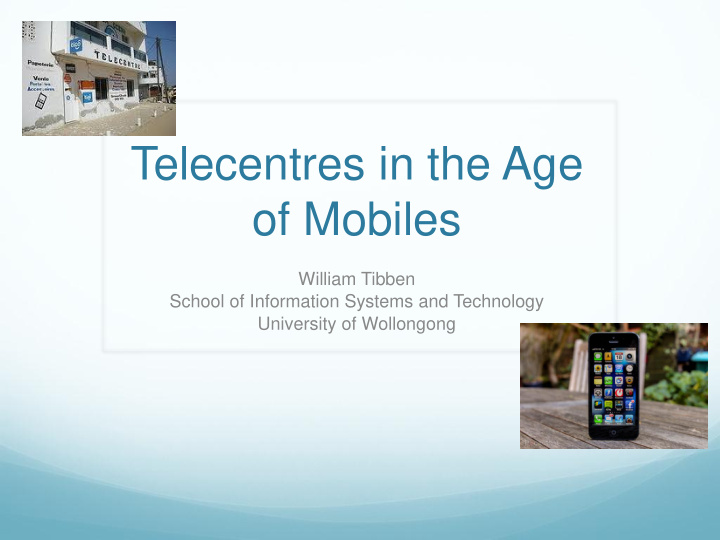



Telecentres in the Age of Mobiles William Tibben School of Information Systems and Technology University of Wollongong
‘Communities need to to be the architects of their own sustainability rather than just rely on the words of benevolent guardians.’ Wiseman Nkuhlu Keynote address to the CIRN 2005, 2nd annual conference of the Community Informatics Research Network, Cape Peninsula, University of Technology, Cape Town, 24-26 August 2005
Telecentre History What is a telecentre? Public places that enable people to experience shared use of modern ICTs, and often the Internet Earliest accounts of telecentres … earliest examples found in accounts of the first telecottages in the Swedish town of Faergelanda in 1987 (Fuchs, 1998) Patterns of development have been diverse e- education, e- health, e-politics, e-commerce
Telecentres are not just about the Internet Telecentres provide access to a range of technologies – not just the Internet Computers, printers scanners, cameras, fax machines
Telecentres are all about community Telecentres work very well in communities because telecentres are about shared access They provide a place where people can learn from each other The social connections that telecentre provide enable community members to work together to develop initiatives
Telecentres and sustainability Greater focus on economic outcomes has led to attention on sustainability The theme of sustainability has not always been an issue In response, people have broadened the definition of sustainability to highlight social benefits The term social capital is used to highlight improved social relationships and action
Telecentres in the Age of Mobiles Mobile technologies provide accessibility to the Internet Some ask… Are telecentres still an appropriate way to provide access to ICTs and the Internet?
Telecentres in the Age of Mobiles Mobile technologies provide accessibility to the Internet Some ask… Are telecentres still an appropriate way to provide access to ICTs and the Internet? YES!
Telecentres are more then access point to the Internet Telecentres provide access to a range of technologies Computers, printers scanners, cameras, fax machines Telecentres are a place where people meet making it a social hub as much a technical hub.
Telecentres mediate access Telecentres are involved in a range of initiatives Some examples from my research into Community Technology Centres (CTCs) in NSW are following
Government
Training services Hosting of groups
Multimedia production Business Support Other commercial activities
Telecentres mediate access Mobile technologies allow direct access to the Internet We all know about the dangers that the Internet poses to vulnerable groups Loss of: privacy, money, identity Telecentres can mediate access supervise filter educate
Telecentres connect the local to the global The clashes between the local and the global Globalisation has both benefits and dangers Telecentres provide ways to manage this connection between the local and the global. Check out openentry.com Youtube clip on Open Entry
Network effects Telecentres seem to work better if they belong to a telecentre network or a group of telecentres A telecentre umbrella organisation can reduce the overheads of dealing with large customers such as government or small finance providers The umbrella organisation can negotiate collective contracts on behalf of a number of CTCs
Should government support telecentres? There is a strong evidence that telecentres are a low cost service delivery point for government and the private sector Governments generally are sceptical of telecentres – “Are they sustainable?” they will often ask Strategies to reduce negative perceptions
Should government support telecentres? Strategies to reduce negative perceptions
Should government support telecentres? Strategies to reduce negative perceptions Well managed operation (accounts, business plan) commercial services evidence of community support
Qs?
Recommend
More recommend